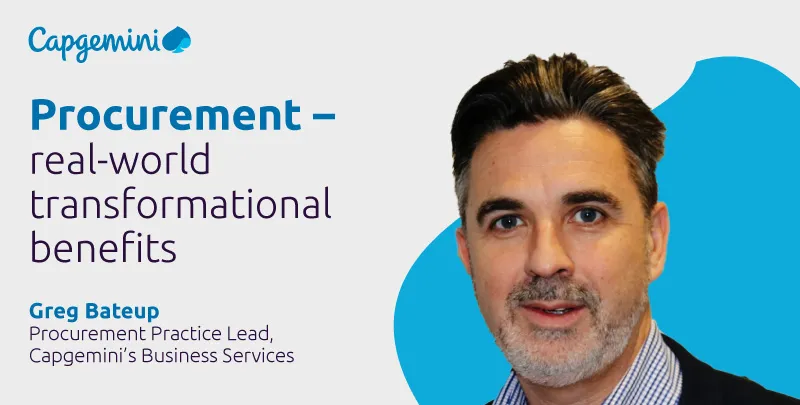Procurement – real-world transformational benefits
Blog: Capgemini CTO Blog
In the first article in this short series, we headlined the challenges facing the procurement function. We also considered the changing nature of its role. In the second article, we looked at how procurement could be integrated into a smart, enterprise-wide, digital model, as part of what we at Capgemini call the Frictionless Enterprise.
In this, the third and final article in the series, we’re going to assess some real-world implementations of this smart, integrated approach to procurement. In each case, you’ll see some impressive – and measurable – operational benefits; but you’ll also see the extent to which new procurement models can make a significant contribution to business strategy.
Case #1 – financial services
This multinational financial services company sought to increase procurement efficiency in general, and in particular to improve purchasing compliance in its global insurance business.
A digital global approach was introduced that included an outsourcing model, a user-friendly buying portal, intelligent automation, a closed loop process for compliance and change management, and a Command Center concept to provide greater visibility into process bottlenecks.
In fact, visibility was improved not just in this respect, but across the entire procure-to-pay (P2P) function. Processes were harmonized globally across business units, and scalable, fit-for-purpose platforms maintained compliance, and locked in savings.
As a result, the organization achieved 30% productivity gains over five years. There was a 90% increase in purchase order (PO) compliance, savings of over 10% in tail-spend management, an increase in no-touch POs to 80%, and a significant improvement in end-user satisfaction.
Case #2 – food
One of the world’s largest food companies was experiencing delays in processing purchase requisitions which led to internal customer dissatisfaction, delayed internal projects and a loss of revenue. PO compliance was at only 40%, limiting control over purchasing, and 30% of purchases required multiple touches which further delayed on-time payment to suppliers. In addition, poor data visibility meant it was difficult to identify savings.
A global managed service process model was introduced, with standardized desktop procedures, including the use of a catalog that was generated using improved content via analysis of repeat spend and training. Functions including PO processing, PO cancellations and changes, and invoice exception handling were monitored against new SLA-based metrics.
The new model reduced the number of interactions per transaction, leading to a significant improvement in on-time supplier payment. In fact, over three years, there was an increase in touchless POs of up to 63%, as well as a 90% increase in PO compliance. There was a 75% improvement in invoice block resolution, and a year-on-year rise of 10% in the productivity of full-time employees.
Procurement – key to strategic success
As I said in the introduction to this article, while all these stats are impressive, it’s not just about measurable benefits. In this last case, for instance, what is perhaps more important than any one operational improvement is that the procurement function is now much more closely aligned to the company’s business objectives.
We need to see procurement for what it is – not merely as a fulfillment service, but as an important contributor to the strategic and tactical success of an organization. When it’s part of a Frictionless Enterprise, procurement can give businesses the flexibility, the cost-effectiveness, and the resources they need in order to go out and win.
To find out how Capgemini’s Digital Procurement Services offer maximize your digital investment to drive compliance and control across your procurement function, contact: greg.bateup@capgemini.com
Read other blogs in this series –
Greg Bateup has worked with clients to deliver business transformation and BPO services for almost 30 years. For the last few years, Greg has focused on the digital transformation of the source-to-pay function, and how organizations can not only drive efficiencies in the procurement function, but also drive compliance and savings.
